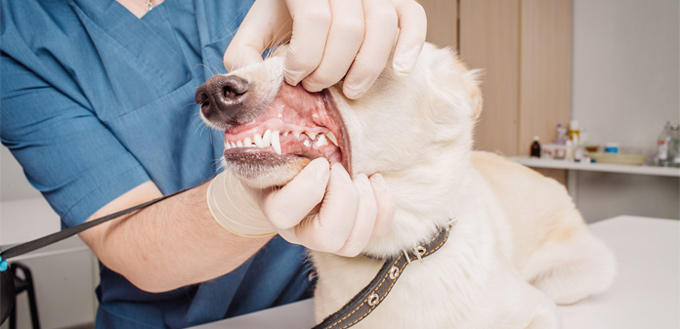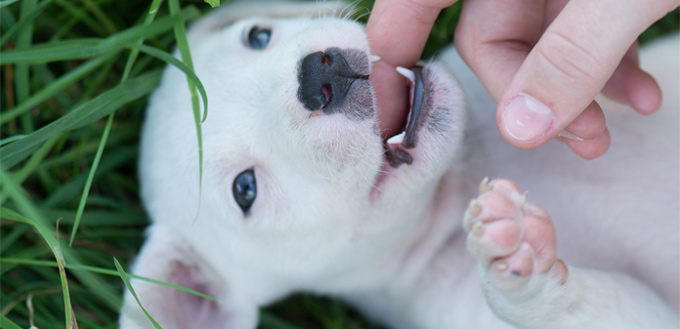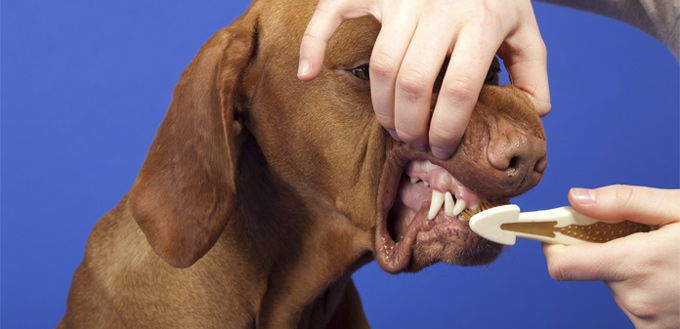The anatomy of a dog is fascinating because every part of its body is well-adapted for its environment and way of life.
Though dogs have been domesticated for many centuries, many of their body parts are still designed for a life in the wild. The mouth, teeth, and the head formation of dogs is perfectly adapted for their canine instincts.
As a pet owner, it is important to know how their mouth and teeth are organized, so you can give the best possible care for it.
In this article, we will examine many aspects of its teeth, including the total count and formation.

How Many Teeth do Dogs Have?
Dogs have a total of 42 teeth when compared to the 32 in humans. However, the total number of milk teeth and the total number of permanent teeth are not the same, as the puppies have only 28 teeth. In this sense, they are similar to humans, as the puppies have deciduous teeth that fall and give way to permanent teeth.
The following are the different types of teeth in a dog.
- Incisors
Incisors are the teeth that are present right in the front, both in the lower and upper parts of the jaw. There are about 12 incisor teeth, with six on each jaw. These teeth are small and sharp, and this is what the dog uses for pulling objects, scratching and for picking up objects.
- Canines
Also called fangs, this is one of the most popular teeth of the dog, thanks to dogs and vampire movies. These teeth are located right next to the incisors and they are long and pointed. There are four canines, two on each jaw, right next to the four corner incisors.
These teeth are used for tearing and grabbing things. If you see two dogs fighting, you’ll see a lot of this canine teeth.
- Premolars
Premolars are the teeth located next to the canines. They are broad, flat and pointed. These premolars are used for chewing, tearing and biting different foods. There are 16 premolars, eight on each jaw.
You can see these premolars when you throw a stick and the dog grabs it.
- Molars
The main function of molars is to chew the food, so it is ideal for digestion. They are bigger and sharper than the premolars. The dog has ten molars, out of which six are in the lower jaw and four on the upper jaw. In the lower jaw, there are three molars on either side of the jaw and in the upper jaw, two molars are present on either side.
The dog uses it molars to chew hard foods like bones.
Anatomy of Dog’s Teeth
If you take a closer look at the dog’s teeth anatomy, you’ll notice that it is designed based on the natural foods of the dog. Since dogs are carnivores, the molars and premolars help to chew even the hardest of things like bones.
The front teeth are sharp for catching small animals for food while the canines help the dog to close its mouth completely.
Related Post: Best Bones for Dogs
How Many Teeth do Puppies Have?
Just like human babies, puppies also go through the teeth formation process. They have milk teeth, also called deciduous teeth that fall and give way to permanent teeth.
Puppies have 28 teeth when compared to the adult dog’s 42.
Typically, puppies begin losing their teeth around 12 to 16 weeks of age. At the end of four months, at least a few of the puppies milk teeth would be replaced by permanent teeth.
Anatomy of Puppy’s Teeth
Every puppy has 14 teeth each in its upper and lower jaws. It includes,
-
- 12 incisors on the front part if the upper and lower jaws.
- Four canines on either side of the incisors.
- 12 premolars, with six on each jaw and three on each side.
- No molars! Puppies do not have any molars and they developed permanent teeth directly. This explains why puppies should not be given any hard food to eat, as they do not have the molars to chew them.

The Growth of Permanent Teeth
By four months of age, permanent teeth start coming out to replace the deciduous teeth. During this time, permanent teeth develop in the underside of the gums and when it is ready to erupt, they put pressure on the deciduous teeth.
This causes the milk teeth to fall and the roots are absorbed. Once this process is complete, the permanent teeth will push the crown of the baby teeth and will emerge.
This process is called the puppy teething process and during this time, your dog will have the natural urge to chew on anything soft. If you see your pup biting on every possible item in the house, consider buying dog teething toys that are soft to chew and can soothe the pain that comes with the eruption of permanent teeth.
These dog chewing toys can also avoid damages to your upholstery, shoes and other household items. You may also want to consult with your vet to identify the right chewing toys for your pup.
This might get you wondering if you can identify a dog’s age by its teeth.
The answer is, yes, but only to a certain extent. Each tooth has a specific time frame by which it grows. For example, deciduous incisors are in place by 6 weeks while permanent incisors are in place by 12 weeks. So, if you see the incisors, you can guess that the puppy is about four months old.
You May Also Like: Toys for Teething Puppies and Dog Chews

However, this pattern stops when your dog is about six months old because, by that time, all the permanent teeth are in place. After that, you’ll not be able to guess the age of your dog by seeing its teeth.
To conclude, a dog has 42 teeth and 28, when it is a puppy. The teething process begins when a puppy is about four months old and ends by about six months.
Related Post: Best Chew Toys for Puppies
Sources:
- Lorraine Hiscox DVM, Persistent Deciduous Teeth (Baby Teeth) in Dogs, VCA Hospitals
- Dr. Monica Tarantino, How Many Teeth Do Dogs Have, and Can They Lose Them?, PetMD
- Dr. Ernie Ward, Top 10 Dog Dental Questions, Pet Health Network
Note: The advice provided in this post is intended for informational purposes and does not constitute medical advice regarding pets. For an accurate diagnosis of your pet's condition, please make an appointment with your vet.






